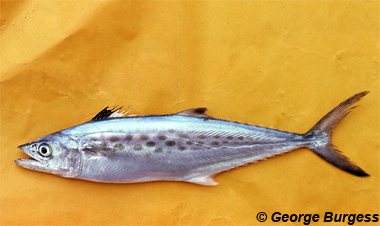
Scomberomorus maculatus
These torpedo-shaped fish have a long, sleek build with a crescent shaped caudal (tail) fin, ideal for speed and maneuverability. They are blue-green from above, and silvery pale all over, with brassy brown oblong spots on their sides. They school at the surface of warm coastal waters of the Western Atlantic, eating smaller fish and migrating with the seasons. A popular food fish, they are carefully managed in both commercial and recreational fisheries, and the population is stable.
Order – Perciformes
Family – Scombridae
Genus – Scomberomorus
Species – maculatus
Common Names
The English language common names for this species are Atlantic spanish mackerel, horse mackerel, spotted mackerel, Spaniard, spotted cybium and Spanish mackerel. Other common names include pyatnistaya makrel, pyatnistaya makrel and ispanskaya makrel (Russian), carite, carite Atlántico, pintada, serrucho, sierra, sierra común and sierra pintada (Spanish); fläckig kungsmakrill (Sweedish); gefleckte königsmakrele (German); makrela hiszpanska (Polish); makréni (Susu); plettet kongemakrel (Danish); serra-espanhola and sororoca (Portuguese); sgombro macchiato (Italian), Spaanse makriel (Afrikaans); taza doré (French creole); thazard Atlantique, thazard blanc and thazard tacheté du sud (French).
Importance to Humans
Spanish mackerel support very extensive commercial and recreational fisheries in the U.S. because of their high food quality and the fish’s fighting ability. Most fishing for this species occurs along the Atlantic coast of the US and in the Gulf of Mexico. Recreational fishermen in Florida are allotted 15 Spanish mackerel per person per day with a minimum size limit of 12 inches (304.8 mm) FL. Spanish mackerel are caught primarily with purse seines and on line gear. It is consumed as fresh, frozen and smoked by humans although the flesh easily becomes rancid in less than three months when frozen. Currently, frozen Spanish mackerel is treated with antioxidants and EDTA (ethylenediaminetetraacetic acid) which is used as a preservative.
Conservation
The IUCN is a global union of states, governmental agencies, and non-governmental organizations in a partnership that assesses the conservation status of species.
> Check the status of the Spanish mackerel at the IUCN website.
Geographical Distribution
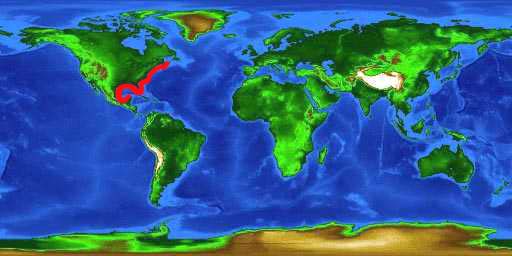
Spanish mackerel are found in the subtropical and tropical waters off North America and the Caribbean. They are locally found along the Atlantic coast from as far north as Nova Scotia (Canada) and south to Florida along the Gulf of Mexico (US). Florida is considered to be the area with the highest abundance of Spanish mackerel This species is also seen along the north coast of Cuba and throughout the Gulf of Mexico to the Yucatan Peninsula. It is replaced from Belize to Brazil by a similar species referred to as Scomberomorus brasiliensis (Collette, Russo, and Zavalla-Camin, 1978).
Habitat
Spanish mackerel are epipelagic, residing at depths ranging from 33-115 feet (10-35 m). They are often found in very large schools near the surface of the water. They frequent barrier islands and the passes associated with these islands and are rarely found in low salinity waters. Spanish mackerel larvae occur mostly offshore while juvenile mackerels are found both offshore and in the beach surf.
Migrating over large distances close to shore, Spanish mackerel in the Atlantic Ocean follow the coastline northward during the warmer summer months and back in the autumn and winter months to waters off Florida. There are some populations of this fish in the Gulf of Mexico that migrate westwards in the early spring to waters off Texas. This species also migrates along the coast of Mexico southward between August and November and then northward again in March and April.
Biology
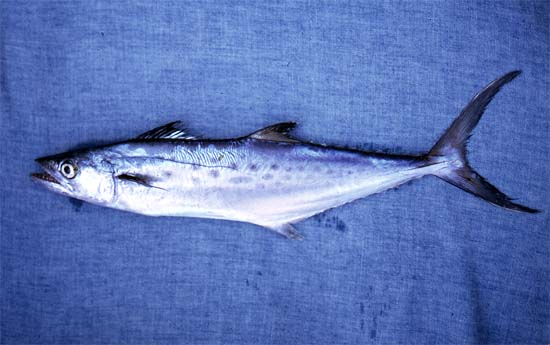
Distinctive Features
The Spanish mackerel has a fusiform body and a pointed snout which is much shorter than the rest of the head. There are two closely spaced dorsal fins. The first dorsal fin has 17 to 19 spines and originates above the pectoral fin base while the second dorsal fin has 17-20 rays. The caudal fin is falciform. Spanish mackerel have no swim bladder and the body is covered with small silvery scales. This mackerel also lacks scales on the pectoral fins except at the bases as does the king mackerel. The lateral line of the Spanish mackerel gradually slopes down toward the caudal peduncle.
Coloration
The Spanish mackerel is iridescent blue-green along the dorsal surface and silver along the sides of the body. There are approximately three rows of large dark elliptical brown and brassy spots along the sides of the body. The number of spots increases with increasing fork length of the mackerel The anterior third of the first dorsal fin is dark in color.
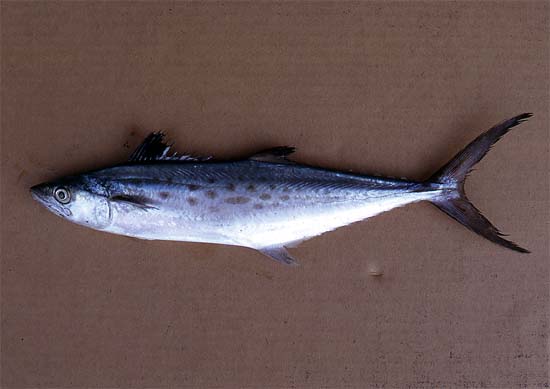
Dentition
The Spanish mackerel has relatively large jaw teeth that are triangular and arranged in a single series. They are closely spaced and flattened from side to side. There are patches of teeth found on both the palatine and the vomer.
Size, Age, and Growth
Spanish mackerel commonly grow to an average size of 8 – 11 lbs. (4 – 5 kg). The maximum reported length of this species is 35.8 inches (91 cm) fork length (FL). Juvenile Spanish mackerel grow rapidly and then start to slow as they reach age 5 for males and age 6 for females. Size at sexual maturity varies between areas and sex (Table 1). The oldest Spanish mackerel sampled was 11 years for females and 10 years for males.
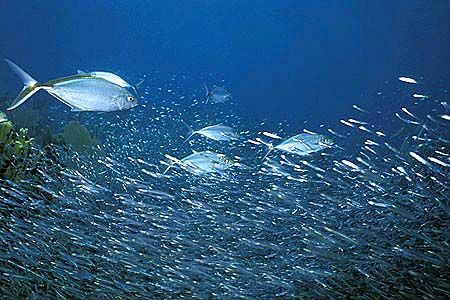
Food Habits
The diet of adult Spanish mackerel consists primarily of smaller fish such as herrings, jacks and sardines. This mackerel is also known to feed in lesser quantities on shrimp and cephalopods.
Reproduction
Spanish mackerel have separate male and female sexes which produce milt and roe (respectively) during reproduction. The gametes are broadcast into the water column and fertilization is external. Spawning most likely takes place between April and October depending on the latitude. Along the inner continental shelf of Texas, spawning occurs from May through September while in the waters off Florida spawning typically occures from July through September. In the more northern portion of its range, the Spanish mackerel spawns from August through September. The eggs are buoyant, round in shape and transparent. Hatching has been documented to occur within 25 hours at 79 degrees Fahrenheit (26 degrees Celsius). It has been reported that the larval stage lasts from approximately 0.12-0.51 inches (0.3 to 1.3 cm) total length (TL). The larvae feed on larval fishes such as carangids, clupeids, and engraulids as well as some crustaceans. Juveniles often utilize estuaries as nursery areas.
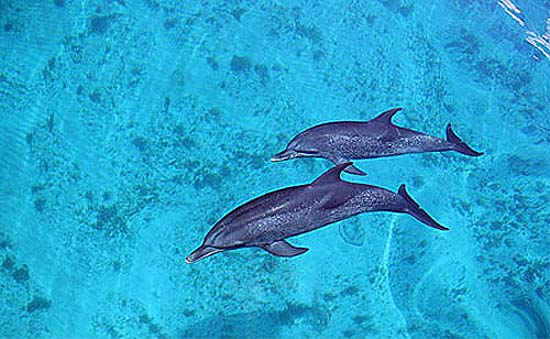
Predators
Adult Spanish mackerel are commonly preyed upon by larger pelagic fish including sharks and tunas as well as bottlenose dolphins while larvae and juveniles are fed on by other immature fishes such as dolphinfish and tuna.Parasites
This fish is commonly described as infested with a variety of parasitic organisms. The Myxozoan parasite Kudoa crumenacan be found in the muscle tissue of Spanish mackerel. Cestodes including Callitetrarhynchus gracilis, Pseudolacistorhynchus noodti, and Otobothrium cysticum are also known parasites of this fish. The trematodes Scomberocotyle scomberomori, Pseudaxine mexicana, Thoracocotyle crocea, and Lithidocotyle acanthophallus have been documented as parasites found in the gills of the Spanish mackerel.
Taxonomy
The Spanish mackerel was originally described as Scomber maculatus by Mitchill in 1815. This scientific name was later changed to Cybium maculatum and then to the currently valid Scomberomorus maculatus (Mitchill 1815). The genus name, Scomberomorus, is derived from the Latin ‘scomber’ translated as mackerel and the Greek ‘moros’ meaning silly or stupid. The species name maculatus is derived from the Greek language and refers to the spots on the body of this fish. Synonyms include the misidentifications of this species as Scomberomorus tritor (non Cuvier, 1831), Scomberomorus sierra (non Jordan & Starks, 1895), and Scomberomorus brasiliensis (non Collete, Russo & Zavalla-Camin, 1978).
Prepared by: Michelle Press